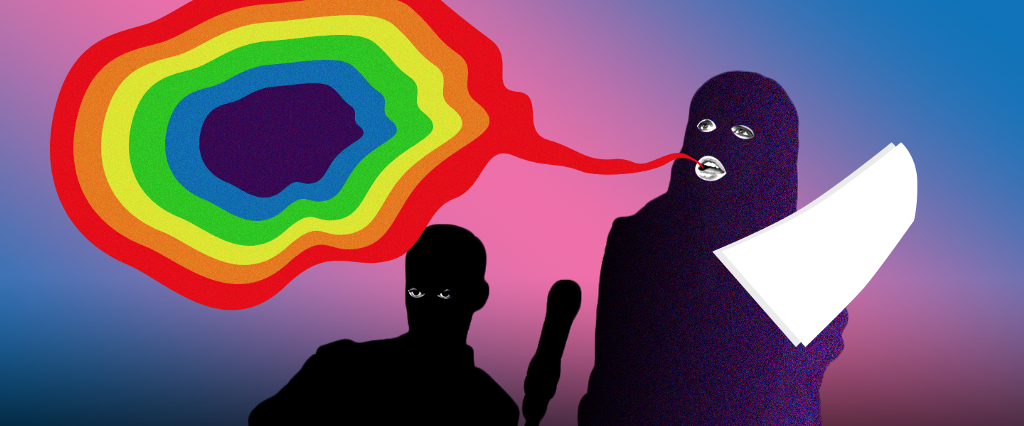The pain, rage, and sorrow of losing a loved one to senseless violence is without estimate. Try to imagine, then, the killer lessening his punishment with a legal defense that frames the victim’s sexual orientation or gender identity as provocation to murder.
It may come as no surprise that currents of homophobia and transphobia run through the criminal justice system. Still, the implications of a recent case like this in Texas have alarmed LGBTQ rights advocates and redoubled calls to action on the issue. Recently, an Austin jury recommended that James Miller, 69, receive ten months probation — not prison time — for the “negligent homicide” of Daniel Spencer, his 32-year-old neighbor, after Spencer allegedly threatened him with a glass for rejecting a kiss. Miller fatally stabbed him with a knife. There were no witnesses, and there was no physical evidence that Spencer attacked him. The unusual verdict seemed to at once reject Miller’s claim of self-defense and partially absolve him due to his implicit fear of a gay encounter.
Critics were swift to denounce Miller’s attorney for using the so-called “gay panic defense,” which is allowed in the courtrooms of all but two states: California, which formally banned it in 2014, and Illinois, where a similar law went into effect this year. The strategy is far from common, but according to the Williams Institute, a think tank at UCLA Law devoted to LGBTQ law and public policy, it has cropped up in court opinions throughout half the country since the 1960s. Aided by the now-outmoded psychiatric consensus that homosexuality is a mental disorder, lawyers have been able, in a variety of ways, to suggest that assault or murder are partially justified by a disclosure of the victim’s orientation or gender identity if it triggers a sort of mental breakdown in the assailant. One notorious example: James Dixon, who got a lenient 12-year jail sentence in pleading guilty to the manslaughter of Islan Nettles, a trans stranger he’d confessed to beating to death on the street in a “blind fury” after being “fooled” by her appearance.
“Not all court opinions are reported, so we can’t even get to the scope of the problem with the research we’re able to do,” Christy Mallory, State and Local Policy Director of the Williams Institute and co-author of their brief on the gay and trans panic defenses, told me in an interview. “It could be a much larger problem than we’re able to figure out,” which makes it all the more essential to legislate against the tactic.
If it’s possible to do so now, after decades of courts accepting both the validity and effectiveness of a panic defense, it’s because organizations like the Williams Institute and other activists are doing the hard work of reexamining how LGBTQ individuals are perceived in legal settings. As the problems are clarified, they can start on the fixes. “Some of the higher-profile cases, especially involving young people” like Matthew Shepard, whose killers initially said they were enraged by his propositioning them, “have brought attention to the issue,” Mallory said, resulting not only in federal hate crime laws but efforts to extend protections at the state level, where the inroads truly begin.
“The panic defense ban is an innovative way for advancing the cause of LGBTQ people in the face of an administration rolling back their protections,” said Michael Ziri, Director of Public Policy at Equality Illinois, the state’s largest LGBTQ civil rights advocacy organization. Equality Illinois played a significant role in drafting and backing the new law in that state, modeled in part after California’s, and now the spark for related campaigns in New York, Maryland, Michigan, Minnesota and Texas.
“After California, we thought, there’s no way we should let that go on,” Ziri said, furthering the impression of a national domino effect: As Mallory pointed out, people have to hear about this before they’ll do anything to change it. Conquering disbelief is half the battle. “Some folks were like, ‘This can’t be a thing,’” Ziri explained. “But, no, it is. LGBTQ people are blamed for the violence perpetrated against us, particularly trans folks, and trans people of color.”
When Illinois legislators were made aware that attorneys sometimes pursue this objectionable line of thinking, Ziri said, there was significant agreement on ending the practice. Even so, passing a bill was a two-year process involving substantial feedback and bipartisan dialogue. Dr. Anthony Kreis of Chicago-Kent College of Law helped to craft the specifics of the legislation and, in an email, described its evolution:
“[W]e began with the language adopted in California, which is solid as a substantive matter, but it was difficult for some legislators to grasp exactly what we wanted to achieve with it,” he wrote. “So, we revamped the legislation to make it crystal clear that if you hold all other variables constant, if a murder defendant’s claim to mitigate their culpability turned on the victim’s sexual orientation or gender identity, it was not permissible.”
“Once we perfected the language to that effect, legislators jumped on board in bipartisan fashion,” Dr. Kreis wrote. “This was the first piece of LGBTQ civil rights legislation to pass on a unanimous roll call vote in the United States. That’s a huge milestone for the LGBTQ community. In part, that success is a reflection of the odious nature of the LGBTQ panic defense defense, but it is also a byproduct of the Illinois law’s clarity and precision.”
Ziri echoed the importance of cementing the support of both parties for this type of measure, though he added that “in some states that’s just not possible.” Regardless, he’s optimistic about continual and sometimes seismic progress. “How did marriage equality happen so quickly?” he asked. “People came out to their friends and families, they broke down the stereotypes. People sharing their stories has advanced things for LGBTQ people.” He says Equality Illinois is happy to showcase “a model for other states” and will reach across those borders to aid their efforts.
To many, a panic defense ban sounds simple and common-sense. As Mallory succinctly put it: “People can’t say that they were provoked by discovery or knowledge of someone being LGBTQ to mitigate a charge from murder to manslaughter.” But the concept has detractors. In New York, Gov. Andrew Cuomo’s proposal to enact a ban was met with resistance from Assemblyman Joe Lentol, a Brooklyn Democrat who seemed to advance a slippery slope argument against placing limits on defenses available to attorneys. Professor Cynthia Lee of George Washington University Law School has written that although gay panic arguments “reinforce and promote negative stereotypes about gay men as sexual deviants and sexual predators” and capitalize on an “unconscious bias in favor of heterosexuality,” it’s better to air the problematic idea than to ban such discussion outright, thereby forcing bias “to fester in the subconscious realm.”
David Alan Perkiss, an attorney at Los Angeles Superior Court, concurred in his own paper on the case of Lawrence King, a 15-year-old murdered at school by a classmate, urging prosecutors to instead neutralize that defense narrative by targeting “the inconsistencies between the psychology underlying gay panic and gay panic as a legal claim in the presence of the jury.” He acknowledged that gay panic, while it should not reduce culpability, “may very well exist as a legitimate psychological condition.”
Whatever your opinion here, those concerns matter because of the other front in this fight: bigoted juries and lawyers with the talents to exploit that prejudice. The reason a gay or trans panic angle is even an option for a defendant is because it’s a single aspect of a broader story. “There’s tension with hate crime laws,” Mallory said, but the panic defense is nuanced enough to elide that, hinging on questions of mental capacity, self-defense, and provocation. “It’s falling under that umbrella, not just, ‘Someone’s gay and I don’t like them,’” she explained. This requires convincing a jury “that a reasonable person would be provoked, that this is a reasonable response to someone flirting with them or disclosing their identity.”
We saw this in the Texas case, where Miller’s attorney, Charlie Baird, insisted that a ban on the gay panic defense would not have impacted his arguments whatsoever. “Our defense in this case was self-defense,” he said. “There’s nothing about ‘gay panic.’” Nevertheless, with a jury perhaps operating under homophobic bias, one needn’t spell out all the particulars of your victim-blaming.
“One argument against [the Illinois ban] was that people don’t really make those arguments,” Ziri told me. “Clearly they do. To be blamed for your own murder…it’s unconscionable and disgusting.” And whether or not attorneys are subtle enough to fly under the radar with this reasoning, it’s probably worth condemning the maneuver at the highest possible level: LGBTQ people are more likely to be targets of hate crimes than any other minority group, according to the FBI, and it’s vital that we do everything in our power to ensure their identity is not seen as an excuse for that.
To that end, both Mallory and Ziri mentioned winning “hearts and minds” in addition to scoring legislative victories. Despite our attempts to cut jury bias, Mallory said, “you’re never going to be able to stop someone thinking what they’re thinking.” Ziri agreed that while a panic defense ban is an “effective tool,” there remains work ahead in the legal space and in our social culture to combat toxic assumptions and practices. “We’ve had the ability to go back and say, ‘this is not who we are,’ to create remedies and solutions,” he said. It’s this hope — in our willingness to confront old sins — that sustains any push for justice.

